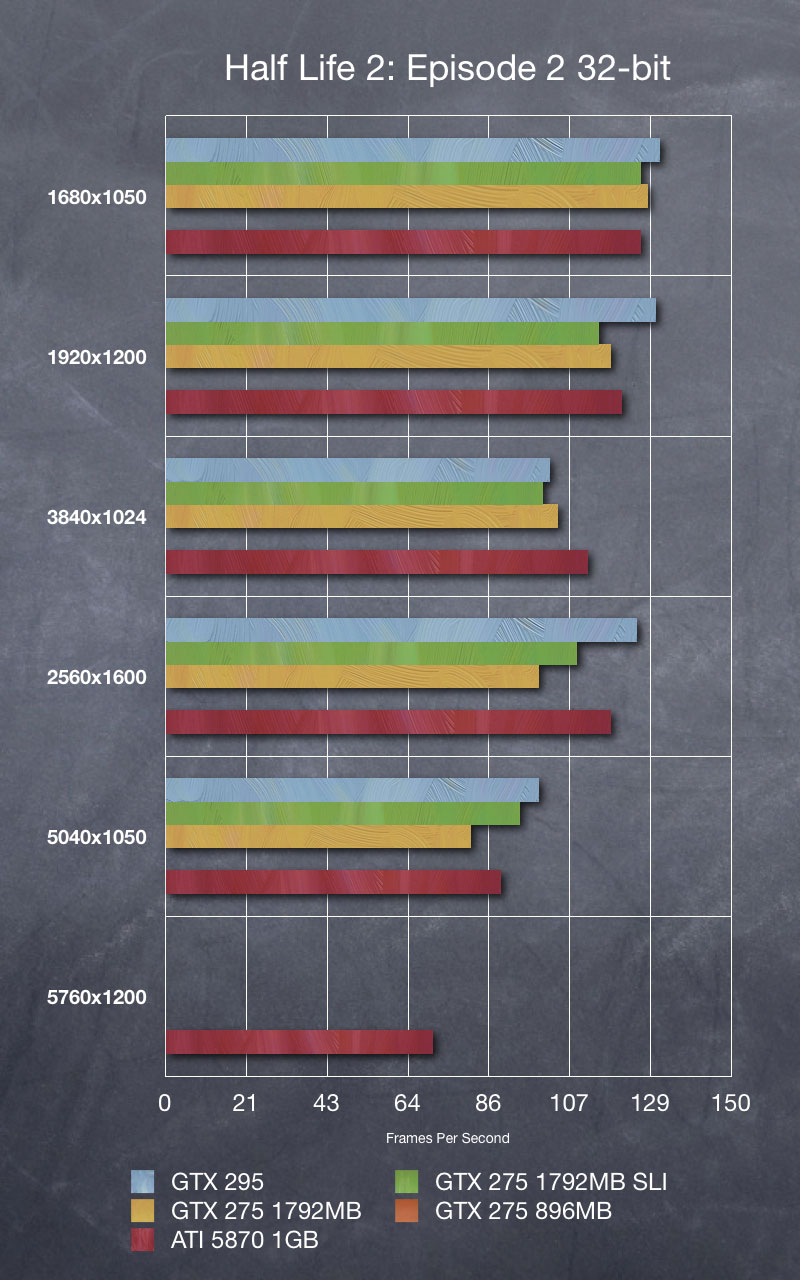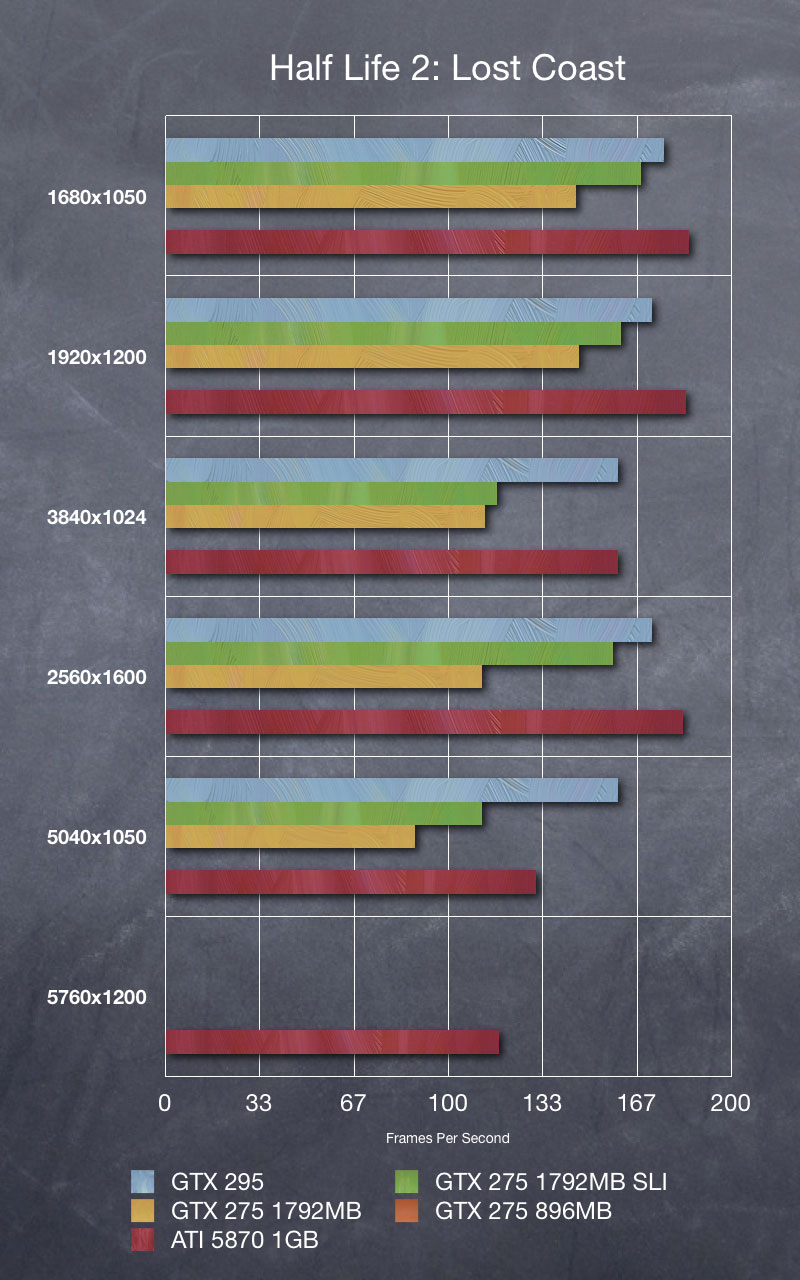Initial ATI Radeon HD 5870 1GB Benchmarks
This article brings us our first benchmarks of an ATI card, and our first experience with EyeFinity. I was fortunate enough for ATI to contact the WSGF, and I was able to obtain an HD 5870 1GB sample for testing. A full review will follow, but I wanted to get the numbers out as soon as I could.
My rig currently stands at:
- ATI Radeon HD 5870 1GB Catalyst 9.10
- EVGA X58 Tri-SLI Motherboard
- Intel i7 920 at 4x2.67GHz
- 12GB G.Skill DDR3 RAM
- 2x Samsung 320GB T-Series HDD (one for the OS and games; one for swap file and FRAPS)
- LG Super Multi Blu (HD-DVD/Blu-Ray Player)
- Onboard audio
- Corsair HX1000
- Antec Skeleton
- Logitch K340 Keyboard & Performance MX Mouse
- 3x Dell U2410
For the EyeFinity testing I've made a few changes to the rig. First I've swapped the three Dell SP2208WFP panels for three Dell U2410 panels. This means moving up to 24" and 1920x1200. I have also dropped the 30" 3007WFP from my workstation as a whole. I have simply run out of desk room. I ran it primarily on my Mac Pro, but now have the Mac hooked up to two of the Dell U2410 panels. I actually get more resolution and real estate, and having multiple screens there is better as well. I also swapped out the huge "gamer" G15 keyboard for something smaller and wireless. Same with the mouse.
In the first parts of the series, we looked at the difference between the 896MB and 1792MB versions of the GTX 275, and then the GTX 275 1792MB in SLI. This was all done in comparison to our original benchmarking of the dual-GPU GTX295.
We found that in general the 1792MB version didn't provide a noticeable difference when comparing "average framerates," but it did provide a noticeably smoother experience (over the 896MB version) (fewer "hiccups") in demanding games such as Far Cry 2. This was particularly noticeable in Wide Surround - 5040x1050.
I expect to have the same findings as we go through the ATI cards - 2GB (and possibly greater cards) will show a benefit at the higher EyeFinity Resolutions. This would be particularly true at 3x1920x1200, which is pushing 6.9M pixels. That is a lot of geometry, and a lot of textures. I dare say that a 4GB card would should performance gains, especially at 4x or 8xAA.
Half-Life 2: Episode 2 & Lost Coast
Based on our previous findings on issues around the 64-bit executables in HL2, we continue to use the 32-bit code.
In the Episode 2 benchmark, the Radeon 5870 holds even with basically every NV card combination we have tested, pulling ahead in the 3840x1024 multi-mon configuration. We would expect the same at 5040x1050 and 5760x1200, however we are unable to do a comparison. The ATI drivers don't support the "non-native" 5040x1050 on the 24" panel (though they do on native panels), and the TripleHead2Go (used for the NV testing) doesn't support 5760x1200. THe Radeon is pushing 60+ fps at 5760x1200 at max settings.
For Half-Life 2: Lost Coast the 5870 consistently beats every NV card combination - even the dual-GPU GTX295, and the GTX275 1792MB in SLI (with more GPUs and more memory). The Radeon HD 5870 1GB matches the 5040x1050 performance of the GTX 295 - while running at 5760x1200. The difference between 5.3M and 6.9M pixels is 30.6% or 1.6M pixels. HL2:LC isn't the most demanding of games, but the huge increase in performance is impressive
However, the single 5870 is basically overkill at all but 5760x1200, but that where most of us would play. ;-). Otherwise you will see performance in the 100+ fps range, and the game is basically CPU locked. Also, at the 100+fps instances, the card does not emit the horrid whine of the NV GTX200 series.


Initial ATI Radeon HD 5870 1GB Benchmarks - Far Cry 2 & Conclusions
Far Cry 2
Far Cry 2 is a far more demanding game than Half-Life 2. As before, we tested with the built-in benchmark tool, using Ultra settings and 4xAA. Previously, no card combination reached 60fps, though the GTX 295 and the GTX 275 SLI come close at 1680x1050 and 1920x1200. The Radeon 5870 breaks this trend, hitting 70-75 at the low end resolutions. The secret here is running in DX10 mode, which not only looks prettier, but is significantly more efficient and produces much better performance.
At 1920x1200 and below, the DX9 performance is comparable to the GTX295 and GTX275 1792MB SLI. THe DX10 performance pulls away, adding a bout 15 fps. Please note that DX10 performance in the NV cards may (or may not have been better). The primary focus of these benchmarks is Surround/EyeFinity. The TripleHead2Go doesn't (or at least didn't at the time) support DX10, so it couldn't be tested. Performance at 2560x1600 is similar between the Radeon 5870 and the NV options.
At 3840x1024 the Radeon 5870 clearly shows its muscle and pulls away from the NV configurations. THe DX9 run adds about 10fps, while the DX10 run adds about 15fps and closes in on 60fps. With a few tweaks (remember we're running 4xAA at Ultra), you can have 3840x1024 at 60fps+.
As before I a full AA analysis. I tested both 5760x1200 and 5040x1050 at High, Very High and Ultra High settings (DX10 doesn't offer "Medium"). All res and quality combinations were tested at 0xAA, 2xAA, 4xAA and 8xAA. At 5760x1200 we could get 8xAA on High and Very High; at 5040x1050 we could get 8xAA on Ultra. The NV cards were previously only able to pull 8xAA at 5040x1050, under Medium settings, and only with the GTX 275 1792MB and above. The added horsepower of the Radeon 5870 is clearly apparent at higher AA settings.
Performance in Far Cry two is outstanding on the Radeon 5870 1GB, while running at 5760x1200. Except for 8xAA, each step from 0x, 2x to 4x drops fps by about 10 frames. The one standout is 8xAA, which takes a huge hit and it totally unplayable. It will not load in Ultra. One thing to note is the minimal impact of going form High, to Very High to Ultra. All of the NV cards took huge hits in performance as you moved up the quality scale. The ATI card produces single digit impacts at each quality step. IMHO, this is a huge feat with regards to the power of the 5870.


Conclusions
Even if you are not considering EyeFinity into your "value proposition," the Radeon 5870 is a serious card with a great price/performance ratio. If you have a high-end NVIDIA setup, and play mostly DX9 and/or Source games, then you have no reason to upgrade. However, if you're a generation back and/or you play DX10 games, the Radeon is really the only way to go. Beyond EyeFinity, it's support of DX10, DX10.1 and DX11 provides huge performance boosts and a large amount of future-proofing.
In Source games, the high-end NVIDIA configurations run neck-and-neck with the Radeon 5870 in widescreen - some better, some worse. They are all within about 5%-7% of each other, and are in the 120+ fps range. The Radeon does pull ahead in the EyeFinity configurations.
The Radeon 5870 truly shines in Far Cry 2, especially in DX10. The card bests the NVIDIA crowd in both DX9 and DX10, often by signifcant margins. The single 5870 beats the dual-GPU GTX295 and a GTX275 SLI setup. Its performance at 5760x1200 (3x1920x1200) even beats the high-end NVIDIA performance at 5040x1050 (3x1680x1050) - while pushing significantly more pixels. Additionally, the Radeon is able to hold its performance while turning up the AA and quality settings, and basically any combination. While dialing up the quality settings took a significant toll on NVIDIA crowd, it only made single digit impacts on the Radeon.
At a lower price point, lower heat, lower power, and lower noise (no damn whine) than the GTX295 and GTX275 SLI, the Radeon 5870 is the far better value on the block - according to the numbers.
What's Next?
This just covers the numbers and the data. I am working on a full review that will cover the drivers, resolution issues, the Catalyst panel (hint: I'm not a fan) and EyeFinity setup and performance. That should be out in the next few days.
We are also working to secure additional cards for benchmarking. We saw with the NVIDIA GTX275 that more VRAM helped to alleviate hiccups during the Far Cry 2 benchmark and provide smoother performance at 5040x1050 (though it didn't change the overall average fps). We had hoped to get 1GB and 2GB versions of the GTX285 for further comparison, but EVGA isn't returning my calls anymore.
Once the EyeFinity6 card is out, we should be able to run similar analysis as it is a 2GB card. And, we're looking to get a 5970 as well in the near future. The CrossFire setup with 2GB on each GPU will certainly help. At 5760x1200, I dare say that a 4GB card would actually show a benefit - at least at higher AA settings.
And Finally, I will be moving over to Windows 7. I'll re-baseline everything. I don't expect any real differences (based on other reviews of Win7), but I need to switch over to stay current and take full advantage of DX11. And besides, it's less painful than Vista.